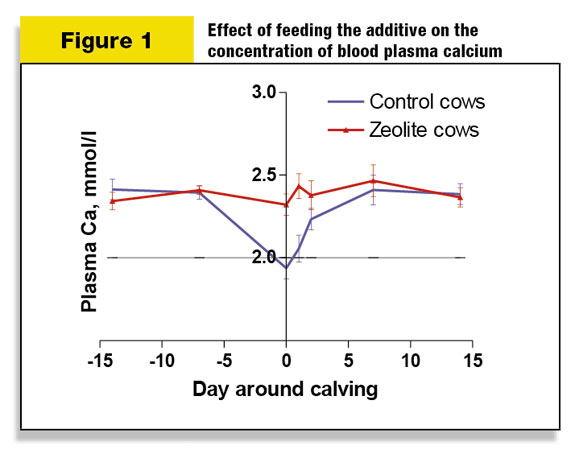A new synthetic zeolite feed additive that binds to calcium in dry cow feed and helps prevent milk fever is grabbing attention in Canada. The new product was introduced in 2009 and was originally marketed in Europe in 2008. Seven farms throughout the country are now using the new product.
The new feed supplement, known as X-Zelit, helps reduce hypocalcaemia or milk fever in fresh cows. The additive is distributed by Vitfoss, a manufacturer of vitamin and mineral premixes for feed.
Professor Rolf Jess Jorgensen of the University of Copenhagen in Denmark has been researching methods to improve calcium deficiency in fresh cows.
He spent more than 10 years developing the methodology behind X-Zelit. Since then the product has proven to strengthen cows’ own defenses against milk fever and provide for more stable milk production.
Per Theilgaard, who heads technical service for ruminant products at Vitfoss, says subclinical and clinical milk fever have high costs for dairy farmers.
Theilgaard says the incidence of subclinical and clinical milk fever has recently been quantified in a study performed in the U.S. According to that study, conducted by Timothy A. Reinhardt of Iowa State University’s College of Veterinary Medicine, the disease incidence increases with age, so that more than 5 percent of multiparous cows got the disease clinically and more than 50 percent of cows had the disease subclinically.
Theilgaard claims the new additive can make a substantial difference in incidence rates, almost completely preventing milk fever cases.
“The benefit producers will receive from the product is an 80 percent or more reduction in the number of clinical milk fever cases,” Theilgaard says.
He also says multiparous cows fed 500 grams of the additive will respond with more than 1.2 kg extra milk per day during the first 100 days in milk.
“Using this product could help you save all the money used on magnesium chloride during the dry period to decrease DCAD.”
DCAD or dietary cation-anion difference measures the buffering capacity and acidity in a cow’s blood. Lowering a cow’s DCAD score before calving has been a traditional way dairymen have combated the threat of milk fever at transition.
Rather than preparing the cow’s blood to absorb and carry more calcium after calving, the feed additive prohibits feed-accessible calcium and tricks the cow into mobilizing bone calcium before calving.
Jen and Theo Van Der Meulen, owners of Van Der Meulen Dairy in Alma, Ontario, have been using the feed additive for about one year.
“The product is very easy to use; we just top-dress our feed for our cows starting two weeks before calving,” Van Der Meulen says. “The cows responded to it as if it were a treat and really seemed to enjoy it.
More importantly, we’ve noticed very few milk fevers.” Van Der Meulen says he’s also found fewer dairy cattle with ketosis as well.
Theilgaard says X-Zelit is a sodium silicate. It binds calcium available in feed, making it inaccessible to the cow. With less calcium available in feed, research shows the cow will adjust her own hormones to the low-calcium environment condition and begin accessing calcium from her own bones.
Theilgaard says producers stop providing the feed additive when the cow calves, making the feed-available calcium accessible again. This, in addition to having already jump-started the cow’s own natural calcium reserves, helps the cow avoid calcium deficiency.

Figure 1 illustrates research about the effect of feeding the additive on the concentration of blood plasma calcium in the dry period compared with a control group. This figure was completed by Professor Jorgensen and Vitfoss.
The additive should be fed at 500 grams or 1.1 pounds per day to dry cows in the 14 days before parturition, Theilgaard recommends.
The price for one 14-day treatment, which is equal to 7 kilograms, is $35 to $39. “This price is higher than the cost of treatment with a calcium carbonate in bolus,” Theilgaard says. However, he also says the product is intended to be used for prevention and not treatment of milk fever. PD
For more information or to purchase X-Zelit, please visit www.protekta.ca. You can also email protekta@protekta.ca or call (519) 528-5888.
YOUR RESULTS
Would you benefit from this type of feed additive?
The following checklist can be used to determine if this new technology might be a fit for your operation.
1. Do you experience milk fever on your farm?
2. Would you like to prevent milk fever cases?
3. Would you like an easy 14-day solution for milk fever by adding a simple product to your feed?
4. In addition to prevention of milk fever, would you like to see 1.2 kg extra milk per day?
5. Would you like to save money on magnesium chloride, used to decrease DCAD during the dry period?
6. Do you like the idea of a more stable milk production?
7. Do you prefer prevention as opposed to treatment options?
If you answered yes to five or more of these questions, this technology may be one for you to consider.









